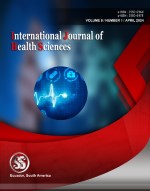Evaluation of Serum Vitamin D levels and their correlation with menstrual irregularities in reproductive-aged women: A cross-sectional study
Keywords:
Vitamin D, Menstrual irregularities, Reproductive health, 25(OH)D, Menstrual cycle, Cross-sectional studyAbstract
Background: Vitamin D plays a vital role in female reproductive health, including regulation of the menstrual cycle. Hypovitaminosis D has been implicated in disorders such as polycystic ovary syndrome (PCOS) and other menstrual irregularities. This study aims to evaluate the serum levels of vitamin D in reproductive-aged women and investigate its association with various patterns of menstrual disturbances. Materials and Methods: A cross-sectional study was conducted on 120 women aged 18–40 years attending the gynecology outpatient department over six months. Participants were categorized into two groups: those with regular menstrual cycles (n=60) and those with irregular cycles (n=60). Detailed menstrual histories were obtained, and serum 25-hydroxyvitamin D [25(OH)D] levels were measured using a chemiluminescent immunoassay. Statistical analyses, including mean comparisons and Pearson correlation, were performed using SPSS version 25.0. Results: The mean serum vitamin D level was significantly lower in women with menstrual irregularities (17.8 ± 5.3 ng/mL) compared to those with regular cycles (28.2 ± 6.1 ng/mL) (p < 0.001). Among women with irregular cycles, 68.3% were vitamin D deficient (<20 ng/mL), whereas only 21.6% of women with regular cycles showed deficiency.
Downloads
References
Singh V, Tamar N, Lone Z, Das E, Sahu R, Majumdar S. Association between serum 25-hydroxy vitamin D level and menstrual cycle length and regularity: A cross-sectional observational study. Int J Reprod Biomed. 2021;19(11):979–86.
Jukic AMZ, Upson K, Harmon QE, Baird DD. Increasing serum 25-hydroxyvitamin D is associated with reduced odds of long menstrual cycles in a cross-sectional study of African American women. Fertil Steril. 2016;106(1):172–9.e2.
Rostami Dovom M, Ramezani Tehrani F, Djalalinia S, Cheraghi L, Behboudi Gandavani S, Azizi F. Menstrual Cycle Irregularity and Metabolic Disorders: A Population-Based Prospective Study. PLoS One. 2016;11(12):e0168402.
Lyngsø J, Ramlau-Hansen CH, Høyer BB, Støvring H, Bonde JP, Jönsson BA, et al. Menstrual cycle characteristics in fertile women from Greenland, Poland and Ukraine exposed to perfluorinated chemicals: a cross-sectional study. Hum Reprod. 2014;29(2):359–67.
Alsaeedi FA, Gharib AF, Hassan AF, Alrehaili AA, Megli Althubiti R, Alharthi FM, et al. Influence of COVID-19 infection/vaccination on menstrual regularity and hormonal function in Saudi females of reproductive age. Heliyon. 2023;9(11):e22291.
Zhang Y, Kong J, Jiang X, Wu J, Wu X. Serum fat-soluble vitamins and the menstrual cycle in women of childbearing age. Food Funct. 2023;14(1):231–9.
Tehrani HG, Mostajeran F, Shahsavari S. The effect of calcium and vitamin D supplementation on menstrual cycle, body mass index and hyperandrogenism state of women with polycystic ovarian syndrome. J Res Med Sci. 2014;19(9):875–80.
Łagowska K. The Relationship between Vitamin D Status and the Menstrual Cycle in Young Women: A Preliminary Study. Nutrients. 2018;10(11):1729.
West S, Lashen H, Bloigu A, Franks S, Puukka K, Ruokonen A, et al. Irregular menstruation and hyperandrogenaemia in adolescence are associated with polycystic ovary syndrome and infertility in later life: Northern Finland Birth Cohort 1986 study. Hum Reprod. 2014;29(10):2339–51.
Kadoura S, Alhalabi M, Nattouf AH. Effect of Calcium and Vitamin D Supplements as an Adjuvant Therapy to Metformin on Menstrual Cycle Abnormalities, Hormonal Profile, and IGF-1 System in Polycystic Ovary Syndrome Patients: A Randomized, Placebo-Controlled Clinical Trial. Adv Pharmacol Sci. 2019;2019:9680390.
Cueto HT, Riis AH, Hatch EE, Wise LA, Rothman KJ, Sørensen HT, et al. Folic acid supplement use and menstrual cycle characteristics: a cross-sectional study of Danish pregnancy planners. Ann Epidemiol. 2015;25(10):723–9.e1.
Younis JS, Iskander R, Fauser BCJM, Izhaki I. Does an association exist between menstrual cycle length within the normal range and ovarian reserve biomarkers during the reproductive years? A systematic review and meta-analysis. Hum Reprod Update. 2020;26(6):904–28.
Milman N, Clausen J, Byg KE. Iron status in 268 Danish women aged 18-30 years: influence of menstruation, contraceptive method, and iron supplementation. Ann Hematol. 1998;77(1–2):13–9.
Jukic AM, Steiner AZ, Baird DD. Lower plasma 25-hydroxyvitamin D is associated with irregular menstrual cycles in a cross-sectional study. Reprod Biol Endocrinol. 2015;13:20.
Gleeson PC, Worsley R, Gavrilidis E, Nathoo S, Ng E, Lee S, et al. Menstrual cycle characteristics in women with persistent schizophrenia. Aust N Z J Psychiatry. 2016;50(5):481–7.
Published
How to Cite
Issue
Section
Copyright (c) 2019 International journal of health sciences

This work is licensed under a Creative Commons Attribution-NonCommercial-NoDerivatives 4.0 International License.
Articles published in the International Journal of Health Sciences (IJHS) are available under Creative Commons Attribution Non-Commercial No Derivatives Licence (CC BY-NC-ND 4.0). Authors retain copyright in their work and grant IJHS right of first publication under CC BY-NC-ND 4.0. Users have the right to read, download, copy, distribute, print, search, or link to the full texts of articles in this journal, and to use them for any other lawful purpose.
Articles published in IJHS can be copied, communicated and shared in their published form for non-commercial purposes provided full attribution is given to the author and the journal. Authors are able to enter into separate, additional contractual arrangements for the non-exclusive distribution of the journal's published version of the work (e.g., post it to an institutional repository or publish it in a book), with an acknowledgment of its initial publication in this journal.
This copyright notice applies to articles published in IJHS volumes 4 onwards. Please read about the copyright notices for previous volumes under Journal History.












